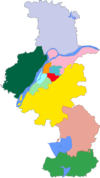Taoye Ferry
| Taoye Ferry | |
|---|---|
Đào diệp độ | |
 | |
| General information | |
| Address | No.43 Qinhuai Gongyuan Street |
| Town or city | Nanjing,JiangsuProvince |
| Country | China |
Taoye Ferry(Chinese:Đào diệp độ;pinyin:táo yè dù), also calledNanpu Ferry(Chinese:Nam phổ độ;pinyin:nán pǔ dù,is a historical place name inNanjing,JiangsuProvince,China.Near the confluence of the Qinhuai River and ancient Qingxi River,[1]the ancient ferry is now situated at the Lishe Bridge (Lợi thiệp kiều) which is to the east of the Jiangnan Examination Hall (Giang nam cống viện)[2]The Huaiqing Bridge (Hoài thanh kiều) lies to its north. Taoye Ferry stretches from Gongyuan East Street to the west of Huaiqing Bridge on Jiankang Road. During theSix Dynasties(229 A.D-589 A.D), it was renowned famous as a place where people said their farewells when leaving. Later it was included among the "48 Scenes of Jinling" (Kim lăng tứ thập bát cảnh).[3]"
Origin of the place name[edit]
It is said thatWang Xianzhi,the seventh son ofWang Xizhi(a renowned calligrapher of theEastern JinDynasty), often awaited his beloved concubine Taoye[4]to be ferried at the crossing. At that time, the inner arm of theQinhuai Riverwas wide and the water was particularly deep and rushed rapidly at the Taoye Ferry. Therefore, boats would often capsize if the ferrymen were not cautious enough about the rough waves and fierce winds. Hence, Wang Xianzhi composed a “Song of Taoye”[5]for his dear concubine to calm her and ease her fears when crossing the river. Therefore, the ferry crossing was named as "Taoye Ferry" in honor of Wang Xianzhi, who awaited his beloved at this site. The song of his goes like this:
- O sweet Taoye, you are my love.
- Cross the river straight and be not afraid.
- Though the boat sails hastily without an oar,
- I shall await here and assure you a safe return.
And Taoye sang a reply on the boat:
- My face and the red blossoms reflect each other's glow,
- And with grace they sway and gentleness I dance.
- Though every girl has her fairness at time of youth,
- I feel grateful as I am the apple in your eye.
Here are the three songs of Taoye by Wang Xianzhi:[6]
(The first song)
- O sweet Taoye, you are my love.
- Cross the river straight and be not afraid.
- Thought the boat sails hastily without an oar,
- I shall await here and assure you a safe return.
(The second song)
- My darling Taoye, thou art my love.
- Taoye joint Taogen as we two are never alone.
- I hold your heart dear, and mine you cannot miss;
- May the pleasures I give you move thee.
(The third song)
- My face and the red blossoms reflect each other's glow,
- And with grace they sway and gentleness I dance.
- Though every girl has her fairness at time of youth,
- I feel grateful as I am the apple in your eye.
History[edit]
For hundreds of years, there had been no bridge over the Taoye Ferry. It was not until the third year in theShun ZhiReign, 1646 that a bridge was built. In order to prevent further drownings, a man named Jin Yunpu in Xiaolingwei (Hiếu lăng vệ) sponsored a wooden bridge. The governor Li Zhengmao greatly appreciated Jin's contribution and named it “Lishe Bridge”, which means that the bridge made it convenient for people to cross the ferry. Although the bridge is no longer extant, the street name of "Lishe" is still in use. Because of the bridge, the ferry structure gradually fell into disrepair during the Republican Era (Dân quốc thời kỳ).[7]
A stele was erected at the original site of the ferry in 1984. Then, in 1987, a memorial arch as well as a pavilion were built north of Taoye Ferry. In 2003, the site was expanded into a heritage park which stretches from the east of Huaiqing Bridge to the Ping Jiangfu Road (Bình giang phủ lộ), with a total area around 5000 m². The park's theme centers on the culture of theSix Dynastiesand possesses a gallery of steles engraved with poems which are written by men of letters of past dynasties about the historical site. Some scenic spots which once were famous across the Nanjing city are also restored.[8]
References[edit]
- ^Qingxi River ( thanh khê ) originates in the Zhongshan Mountain and is an important river in Nanjing.
- ^The Jiangnan Examination Hall was the largest examination hall forimperial examinationin ancient China.
- ^Jinling ( kim lăng ) is the former name of Nanjing. The "48 Scenes of Jinling" can be traced back in theMing Dynasty.Now only about half of the scenes are extant. See alsoShouqing, Xu( từ thọ khanh thanh triều ) (2006).The 48 Scenes of Jinling ( kim lăng tứ thập bát cảnh ).Quảng lăng thư xã.ISBN7-80694-128-2.
- ^Here "Taoye" is the name of the concubine, also referred to as "Peach Leaf".
- ^Lv, Wujin (1996).Nam kinh địa danh thú thoại.Nam kinh xuất bản xã. p. 268.ISBN9787806143131.
- ^Till, Barry (1982).In search of old Nanking China travels, a joint publication China travels.Joint Pub. Co. (Hongkong Branch). p. 241.ISBN9789620401121.
- ^The Republican Era refers to the time of the Republic of China.
- ^"The establishment of the Taoye Ferry Heritage Park ( tái hiện" đào độ lâm lưu "Cảnh quan nam kinh kiến thiết đào diệp độ di chỉ công viên )".Trung tân xã giang tô tân văn võng.2003-05-27.
- Xie, Zhu ( chu tiết ) (2006).Kim lăng cổ tích danh thắng ảnh tập.Trung hoa thư cục. p. 17.ISBN7-101-05249-5.
- Hồng lâu mộng thi từ giám thưởng.Bắc kinh xuất bản xã. 2004. pp. 156 ( đào diệp độ hoài cổ ).ISBN7-200-05081-4.
External links[edit]
- "Đào diệp độ".Kim lăng văn mạch. Archived fromthe originalon 2012-09-27.Retrieved2009-05-24.

